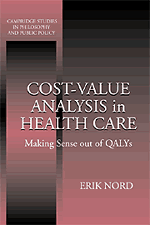Book contents
- Frontmatter
- Contents
- List of Tables and Figures
- Preface and Acknowledgments
- Overview
- Reader's Guide
- 1 Maximizing Value in Health Care
- 2 Three Basic Issues in Economic Evaluation
- 3 QALYs
- 4 Concerns for Fairness
- 5 The Limitations of Utility Measurement
- 6 Ways to Go
- Annex: An Example of Cost-Value Analysis
- References
- Index
Annex: An Example of Cost-Value Analysis
Published online by Cambridge University Press: 06 July 2010
- Frontmatter
- Contents
- List of Tables and Figures
- Preface and Acknowledgments
- Overview
- Reader's Guide
- 1 Maximizing Value in Health Care
- 2 Three Basic Issues in Economic Evaluation
- 3 QALYs
- 4 Concerns for Fairness
- 5 The Limitations of Utility Measurement
- 6 Ways to Go
- Annex: An Example of Cost-Value Analysis
- References
- Index
Summary
Assume that a psychiatric outpatient clinic applies for funds to establish a treatment program for people with chronic anxiety. The treatment will consist of counseling twice a week for three years. A typical patient in the target group is a woman between the ages of thirty and forty who is on disability leave from work. Her anxiety is “bearable” at home, but the patient needs to be accompanied whenever she leaves the house. Assume that it is documented that the therapy will make it possible for the patient to get around alone, function in most social situations, and be partially fit to resume employment, although she will still have symptoms. The treatment will cost approximately US$10,000 per patient.
In order to judge the degree to which the program deserves funding the responsible public health authority compares its estimated results with results in three other areas of health care where there also is a demand for more resources. One is a not yet implemented preventive screening program, and the two others are areas of surgery where there are considerable waiting lists.
The screening program has been proposed for a congenital trait that leads to total invalidization around the age of thirty to forty unless prophylactic treatment is undertaken in time. Assume that the trait occurs in one out of every thousand individuals. Testing for the trait costs US $20,00 per person. Assuming (for simplicity) 100 percent sensitivity and specificity of the test, each positive finding then costs US $20,000. Assume furthermore a 100 percent effective treatment that costs US $10,000.
- Type
- Chapter
- Information
- Cost-Value Analysis in Health CareMaking Sense out of QALYS, pp. 143 - 145Publisher: Cambridge University PressPrint publication year: 1999



